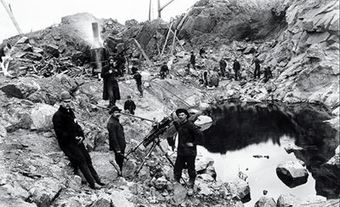Clay
Clay is the common name for a complex group of industrial MINERALS, each characterized by different mineralogy, occurrence and uses. All are natural, earthy, fine-grained minerals composed mainly of water-containing aluminum silicates; they may contain iron, alkalis and alkaline earths (seeSAND AND GRAVEL). The commercial value of clays and of claylike shales depends on proximity to centres where clay products are used, and on their physical properties; eg, they must have moderate plasticity, high dry strength, low shrinkage and low deformation under load. Common clays and shales are the principal raw materials available from Canadian deposits for the manufacture of clay products, eg, common construction bricks, roofing tiles and drainage pipes. Almost all common clays and shales produced in Canada are used domestically.
Fireclays (refractory clays) are used principally in the manufacture of medium- and high-duty firebrick and for crucibles. Known Canadian fireclays are insufficiently refractory (heat resistant) without the addition of some very heat-resistant material, eg, alumina. Stoneware clays are intermediary between low-grade common clays and the high-grade kaolinite clays. They are used for sewer pipe, flue liners, facing brick, pottery, stoneware crocks and jugs and chemical stoneware. Ball clays are heat resistant and composed mainly of fine-particle kaolinite, quartz, illite and mica. They are used mostly in the manufacture of pottery, whiteware (tableware), wall tiles and sanitaryware; they are also used as filler in rubber, plastics, paints and adhesives.
However, widespread use of these clays in Canada has been hampered by distance from markets and lack of proven reserves. Known deposits of kaolin (china clay, composed mainly of kaolinitic minerals), a high-quality clay with more alumina and less silica than ball clays, have not been developed in Canada, primarily because of the extra process required to separate the kaolinitic minerals from the other minerals. All kaolin consumed in Canada is imported, mostly from the US. Kaolin is used mainly as a filler and coating material in the pulp and paper industry; it is also used as a filler in plastics, paints and rubber.
Common clays and shales are mined in most provinces in Canada, but new deposits with improved drying and firing characteristics are sought. Fireclays occur in the Whitemud Formation of southern Saskatchewan and southeastern Alberta and at Sumas Mountain, BC. In Nova Scotia some clays at Shubenacadie are sufficiently heat resistant for medium-duty refractories, and clays from Musquodoboit have been used by foundries in the Atlantic provinces. The principal source of stoneware clay in Canada is the Whitemud Formation. Common clays and shales are mined from open pits using modern, surface MINING equipment. Processing involves crushing, screening, blending and conditioning with water, extruding, firing and drying. Processing of fireclays and of bentonite (an absorptive clay) is more specialized and may involve calcining, in the former case, and acid activation, in the latter.

 Share on Facebook
Share on Facebook Share on X
Share on X Share by Email
Share by Email Share on Google Classroom
Share on Google Classroom

